The cute dome-shaped critter known and dear to our hearts as ladybird is commonly associated with good luck. Most of them are incredibly beneficial to farmers as they feed on agricultural pests such as aphids and scale insects, which are destructive.
However, not to burst your bubble, but ladybugs are not all goody goodies, as we know them. So, do they bite?
Yes, ladybugs can bite. However, their bites aren’t lethal as they have no venomous glands and don’t carry any human diseases. They bite with sharp mandibles, designed to chew soft-bodied insects. They can’t penetrate human skin. They’re more likely to bite hairless areas and only when threatened.
They also bleed on a person, releasing a foul odor; the fluid they secret is their blood. Their presence can trigger allergic reactions and their bites can cause skin welt in allergic people. Read on to discover more about ladybugs.
Are Ladybugs Bugs or Beetles?
Despite the name, ladybugs are actually beetles of the class Insecta and can be found across the world on every continent except Antarctica. Their head is small and carries the mouthparts, antennae, and compound eyes.
They go through a complete metamorphosis, which includes a separate egg, larvae, pupa, and the adult stage. They live for approximately a year, but some can go up to two years.
Females lay eggs on the aphids colonies so that the larva can find an immediate source of food on hatching. Larvae feed on about 25 aphids in a day. Even if they are referred to as ladies, they are not all ladies. Plenty of them are males, and they are smaller than females.
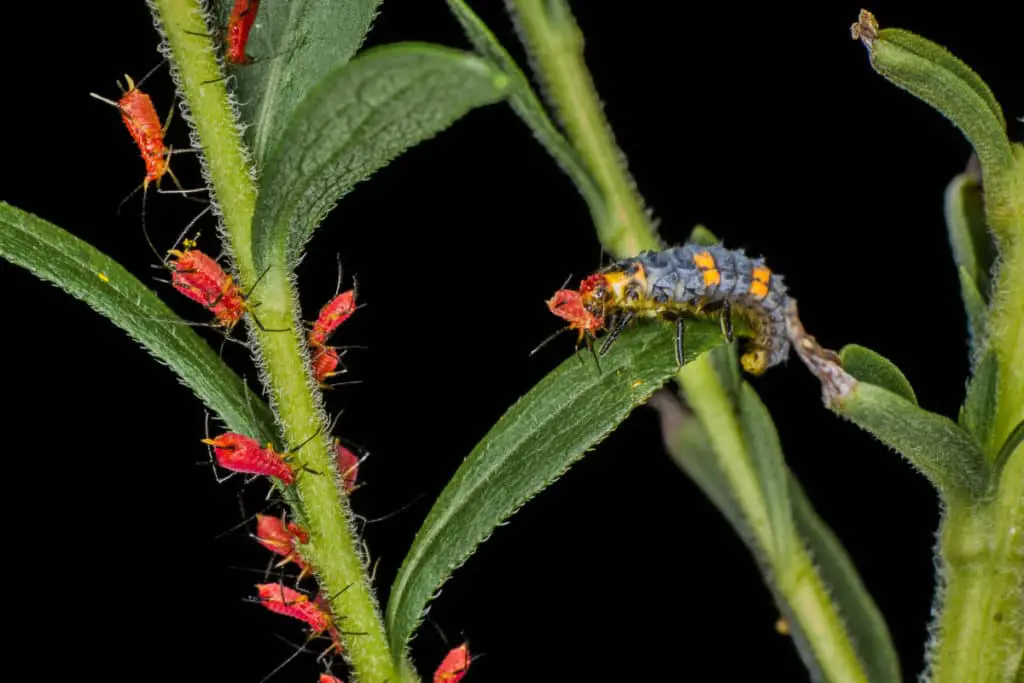
Unlike other bugs that suck up their food, ladybugs have chewing mouthparts. They also feed on mealybugs and mildew.
Do All Ladybugs Bite?
All Ladybugs can bite or pinch since they have mandibles and legs. Although ladybug larvae feed on aphids and look intimidating, they are not harmful to human beings and just crawl around.
Ladybugs Mouth Parts
Ladybugs have strong jaws known as mandibles, which are intentionally built to crush and tear their prey. The mandibles are sickle-shaped and large.
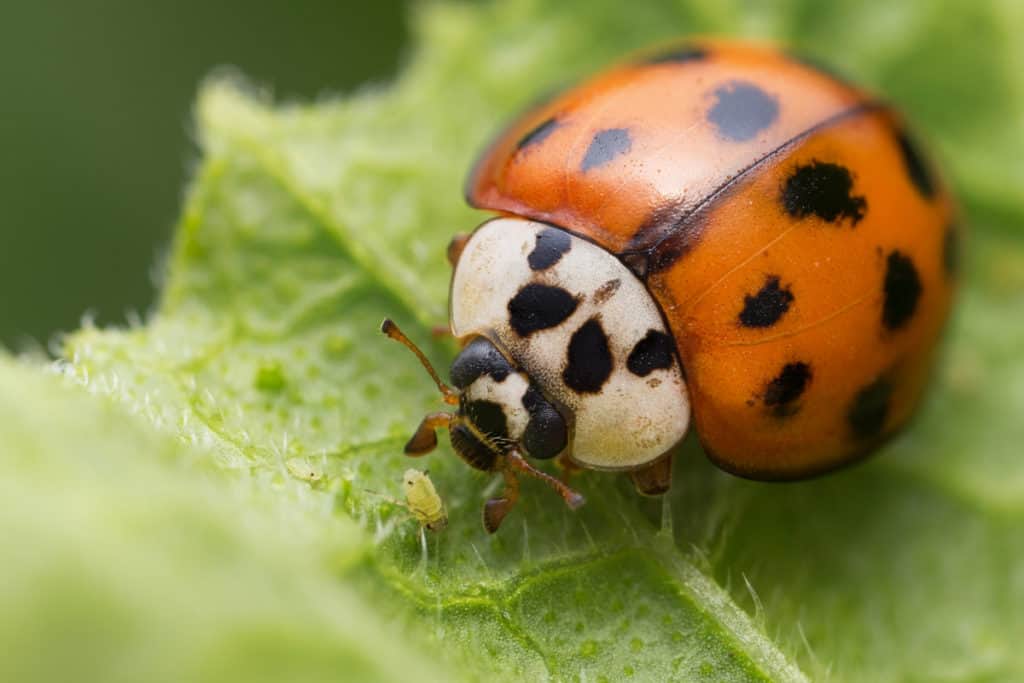
Some ladybirds use their mandibles to cut open the exoskeleton of their prey. Other species inject enzymes in aphids and suck out the digested parts. They do not have saliva or poison glands. Maxillae and maxillary palps help a ladybug to recognize prey.
Why Do Ladybugs Bite People?
Ladybugs love to eat insects and are often beneficial to gardens plagued with pests. When times get tough, the cutesy insects become aggressive voracious predators and go the extra mile to survive. This includes biting people to get some food and water. Some species bite people to obtain salt. They like biting exposed areas such as hands, arms, neck, and head.
One of the species that is an expert in this is the Asian Harlequin ladybird. Unlike mosquitoes, lice, and gnats, they do not have specialized mouthparts to feed on animals or humans. They have a hard time breaking through human skin. The ladybug is known to turn to its own sibling in of food shortage.
How to Treat a Ladybugs Bite
Ladybug bites are not anything to worry about. You can simply wash with water and mild soap to prevent chances of infection. Just in case you have worrying symptoms, it is advisable to seek medical help. Here is a general method to treat a bite by the Asian ladybird
(a) Wash the affected area with mild soap and water immediately
(b) Apply an icepack on the affected area and cold press for at least 10 minutes
(c) Elevate the affected area to help reduce swelling.
It is recommended to avoid scratching to avoid the spread of infection.
What Attracts Ladybugs to Your Home?
Ladybugs invade houses or homes in fall and winter to seek shelter and warmth and hibernate until spring. They can overwinter in your home in large numbers and become a bother. Luckily, they do not reproduce while indoors, unlike other household pests like cockroaches and fleas.
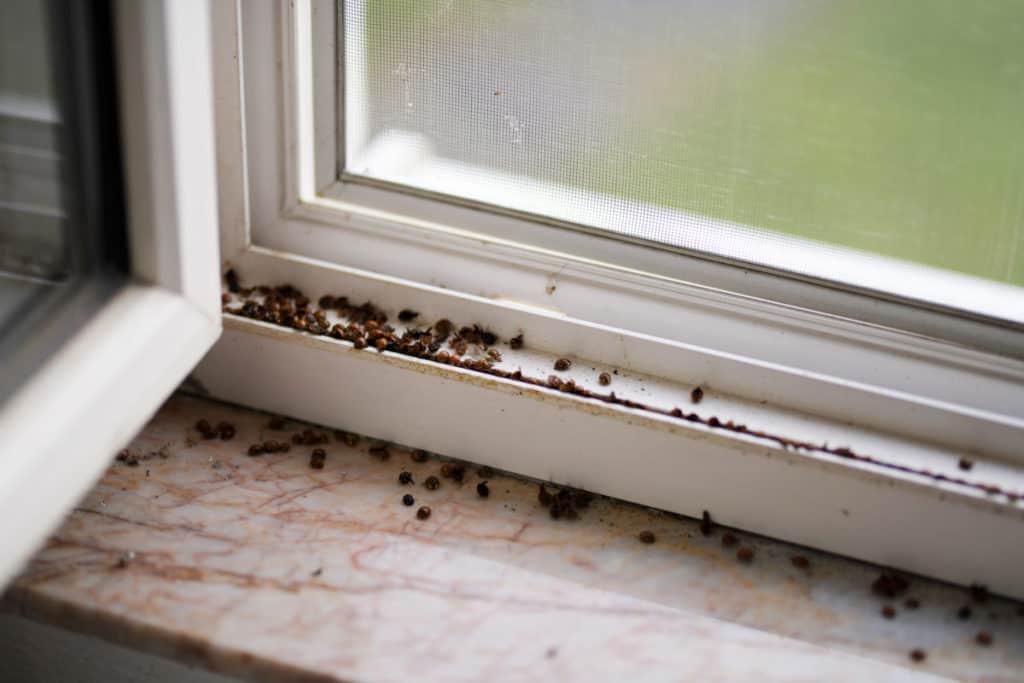
They do not attack clothes, wood, food, and the like. However, the dome-shaped insect secretes a yellowish fluid that stains surfaces they get into contact with.
We have a detailed article related to this topic if your are interested it’s called, Do Ladybugs Have Nests?
Are They Harmful to Pets?
Not all of them. However, the Asian lady beetles are known to be harmful dogs. A dog that loves to chase flying bugs can easily fall prey.
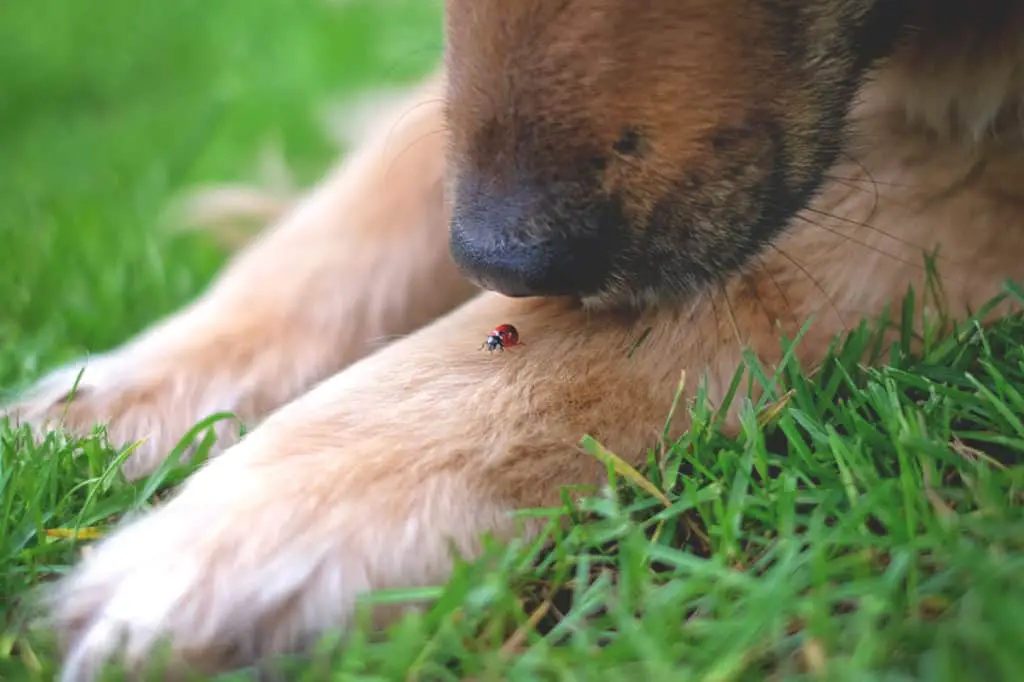
If a beetle gets stuck in the mucosa on the dog’s mouth, it releases its defensive fluid that burns its mouth. Once it is embedded, it is hard for it to leave and also for the dog to remove. It can only be removed manually with fingers, a spoon, or a tongue depressor. Ladybugs cause ulcers on the mouth and tongue and have painful bites.
They can also be harmful to your furry buddies if they eat them. The fluid the ladybirds secrete when a pet such as a dog crushes them in its mouth can cause damage that resembles a chemical burn. They can also cause a burning effect on the gastrointestinal tract.
Some of the signs that may indicate that your dog has eaten a lady beetle include foaming, drowsiness, anorexia, vomiting, drooling, bloody diarrhea, and behavioral changes. If chemical burns are not treated properly, they can result in serious infections.
Why are Ladybirds Colorful?
Their colors depend on the diet, variety, and the region where they live. The patterns also vary – some have squiggles, other stripes, while others are plain, as well as the number of spots which can be from zero to twenty-two.
The colorful bodies are meant to make the ladybug unappealing to their predators, as it signifies to the predators that their taste is terrible. Their head, legs, and antennae are black. It is believed that the more colorful they are, the more unpleasant they are. As they get old, their spots fade.
They secrete an odorous liquid from their leg joints when disturbed, which has an unpleasant taste. Their main predators are birds, wasps, spiders, frogs, and dragonflies. When threatened, the sly critters also play dead.
How Do Ladybugs Help Farmers?
Ladybugs are a beneficial group for farmers. They are natural predators of many insects such as aphids, mealybug, scale, mites, and other sap feeders. The adorable dotted insect especially enjoys the taste of aphids as a single ladybug can consume 75 aphids in a day and about 5,000 in its entire lifetime.
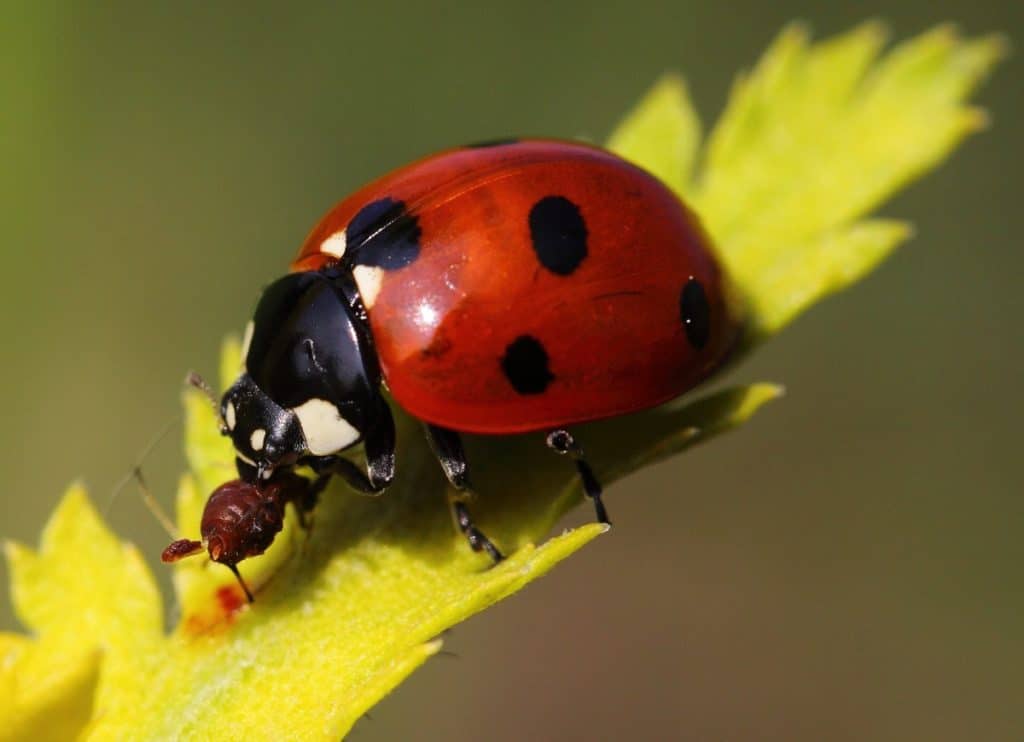
Clusters of ladybug beetles are collected and sold to farmers to control insects on their farms. Although the majority of ladybirds are carnivorous, some are herbivorous and feed on plants. Examples include squash beetle and Mexican bean beetle. Some ladybird overwinters in structures, which make them nuisance pests.
Their larvae are also predators. Adult females lay eggs on plants close to the sac sing insect colonies. After hatching, the larvae prey on insects for a few weeks before pupating on the leaf.
During spring and winter, the ladybird’s population blossoms since the season attracts aphid attacks on foliage. In autumn, adults seek places to overwinter, such as under the rocks, leaves, and also in buildings. Ladybugs can also feed on fruits, grains, and pollen.
Are Asian Lady Beetles Dangerous?
The Asian lady beetle is the least liked version of lady beetles, and often considered a nuisance. They have few natural predators that prey on them and keep multiplying each year.
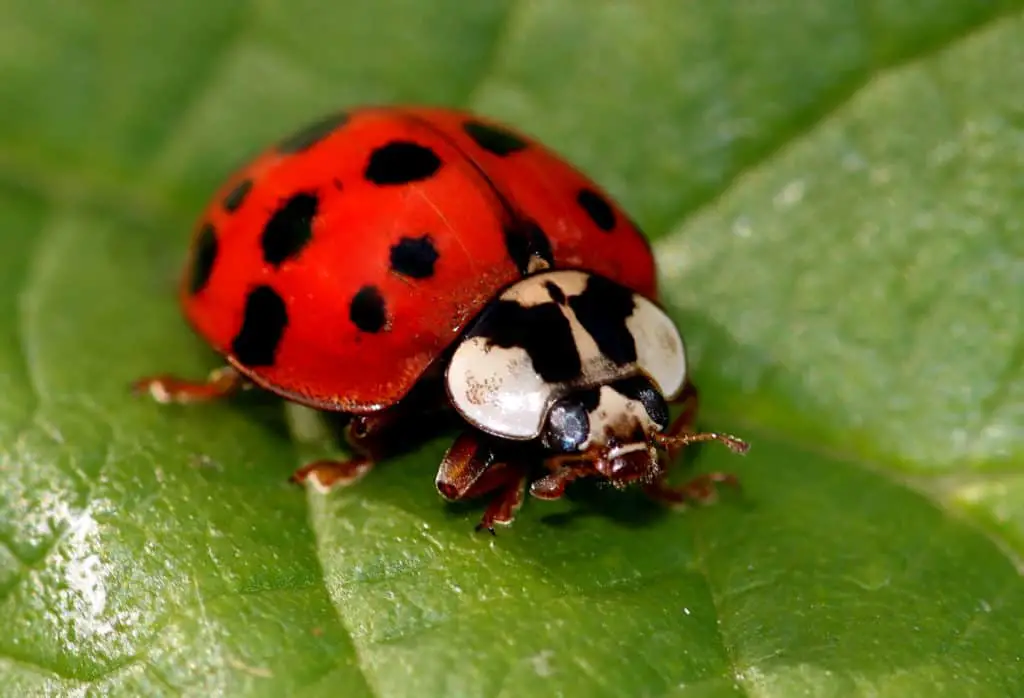
The multicolored Asian lady beetle poses a threat to human health by aggravating asthma and causing allergic reactions in some people. This may result in breathing problems, sneezing, skin redness, harmless bumps on the skin, and a running nose.
They also secrete a yellow foul-smelling liquid that can stain whatever it contacts. So, it is advisable to avoid crushing a ladybug, especially if you are allergic.
Another common allergic reaction is known as rhinoconjunctivitis, which is caused by touching a ladybug and then rubbing your eyes with unclean hands. In some cases, the reaction can be severe and need medical attention. Asian lady beetles were introduced to North America in 1916 to alleviate aphids. Although they help to get rid of aphids, their cons supersede their advantages.
We do have an entire article dedicated to this topic, if you are interested. It’s called, Are Ladybugs Poisonous?
How to Know You Are Dealing With an Asian Lady Beetle
Asian lady beetles resemble the native ladybugs in color, but their distinctive markings can help you differentiate the two. For the Asian beetle, the black section behind the head has an M-shaped white marking and it has a slightly larger body size. The marking varies in size, shape, and thickness, but it is always present.
It is native to the Asian countries (Korea, China, Japan, Russia among others) where it inhabited trees and fields and fed on aphids and scale insects.
During winter, the native lady beetles seek shelter outdoors while the Asian beetle invades houses. White markings on native ladybug are on the sides of the head and look like cheeks.
How to Get Rid of Ladybugs in Your Home
The best way to get rid of Asian lady beetles in your house is by pest-proofing to keep them from gaining entrance. These include sealing cracks in doors, windows, pipes, and utility wires. It is also crucial to ensure all windows and doors are tightly fitted, and screens are not worn out. Here are various ways to control them.
Insecticides
You can spray outside your home from late September to early November before they make an entry to your house to seek shelter for the winter season. Examples of insecticides to use are cypermethrin, deltamethrin, and permethrin.
Cleaning
You can sweep up to remove them from your house. However, be careful not to handle them by hand. If they are handled roughly, their blood will stain the walls and the carpet.
Diatomaceous Earth
Diatomaceous earth is a soft sediment made up of silica, which is a natural pesticide. It is advisable to place it in the main areas of your house. Ladybirds that get stuck in the diatomaceous earth dry out and die.
Light Traps
The bright light will attract and trap them. You can then empty the traps outside your home.
Other Interesting Facts About ladybugs
They are named After the Virgin Mary
You may wonder since they are both males and females, why call them ladies? Well, they are named after a specific lady: the Virgin Mary. It is believed that in the Middle Ages, European crops were infested by pests. Farmers prayed to the Virgin Mary for help, and soon the beautiful insects began to appear in the fields, which saved their crops. They started calling the insects the lady beetle. The seven-spot European ladybug reminded people of the seven sorrows of the Virgin Mary. Germans refer to it as Mary’s beetle.
They Lay Extra Eggs as Food for Their Young Ones
Female ladybugs lay clusters of eggs on plants, some of which are infertile. On hatching, the larvae feed on them. In harsh conditions, ladybugs lay many infertile eggs as a source of food for the young ones and also as their food.
They Fly With Hidden Wings
The ladybirds do not look as though they can fly. Their colorful covering is made up of modified wings, which help in protection. When a ladybug takes off, it lifts the hard shells and uncovers another pair of wings, light and perfect for flight. They are folded for easy storage and only unfold during a flight errand.
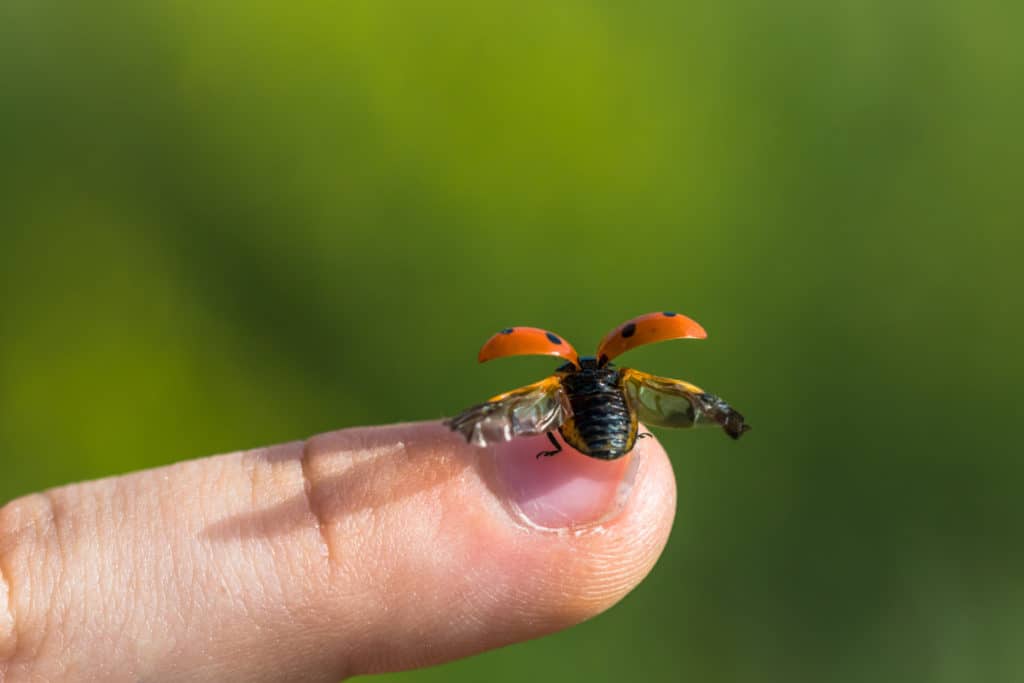
They Can Ruin Your Wine
The harlequin ladybird can be a terror to winemakers. Many vineyards are located near crop fields. Once the crops are harvested, some ladybugs wander to the vineyards and crawl around grapes. The ladybirds may be scooped up together with the grapes, and once the insects are terrified, they secrete their defensive fluid. The resulting wine usually has a stinky flavor.
They Practice Cannibalism
When food is scarce, ladybugs will do all they can to survive? This means even eating each other. A hungry ladybug will feed on any soft-bodied sibling it comes across. Newly emerged adults or larvae make a good meal for the average ladybug. Eggs or pupae are also a good source of food in a hard time.
The Wrap Up
Ladybugs are best known as predators of aphids, scale insects, mealybugs, among others. Their voracious appetite is a blessing to farmers. Although they may take longer than usual pesticides, they eventually work and are environmentally friendly. Pesticides tend to destroy even beneficial insects. Some few ladybug species are however herbivorous and are destructive agricultural pests.
Sources
https://www.britannica.com/animal/ladybug
https://en.wikipedia.org/wiki/Coccinellidae
https://www.healthline.com/health/do-ladybugs-bite#summary
http://entnemdept.ufl.edu/creatures/beneficial/lady_beetles.htm
https://entomology.ca.uky.edu/ef416
https://www.orkin.com/other/beetles/ladybugs-asian-lady-beetles
